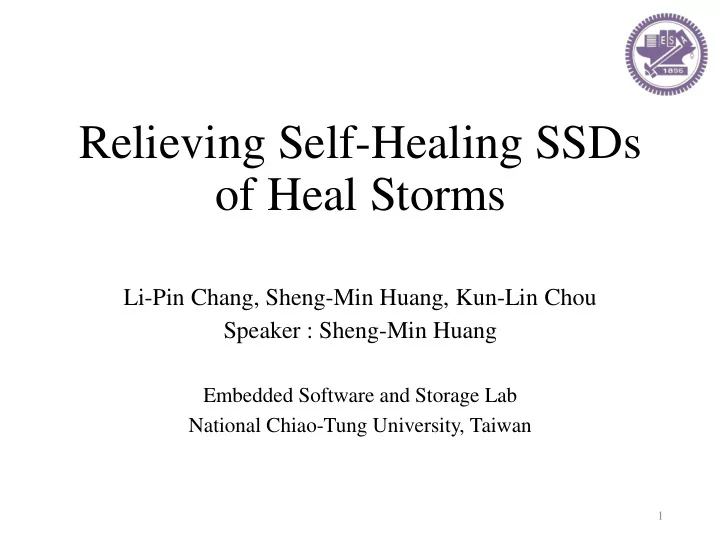

Relieving Self-Healing SSDs of Heal Storms Li-Pin Chang, Sheng-Min Huang, Kun-Lin Chou Speaker : Sheng-Min Huang Embedded Software and Storage Lab National Chiao-Tung University, Taiwan 1
Outline • Introduction • Heal Storm • Virtual Wear Leveling • Experiment Results • Conclusion 2
Flash Wear Out Dynamics • Charge may trap in tunnel oxide after PE cycles. Control gate Gate oxide Floating gate Trapped electrons Tunnel oxide Drain Source Silicon subtract • The threshold voltage shift will become intolerably large and create erroneous bit values. TLC (110) (111) (011) (001) (101) (100) (000) (010) Vr1 Vr2 Vr3 Vr4 Vr5 Vr6 Vr7 Vpass 3
Flash Healing • Trapped charge (stress) dissipate slowly over time. • Accelerate this process under high temperature. • Healing : Heated-Accelerated Self Recovery [2, 3] • Word line heaters to create high temp. BL<1> BL<2> BL<K> • Block heal operation for system software ... • Heal nearly worn-out blocks WL<N> • Time cost is about one second [3, 4] ... ... ... • Relieve about 80% stress [5] ... Heater WL<2> ... WL<1> ... WL<0> 4
Heal Storms • Wear Leveling (WL) • Strive to balance the erase count of all blocks • Self-healing flash memory heals flash blocks when blocks reach their PE cycle limit. • Heal storm , blocks undergo block-healing within a short period of time. 5
Negative Effects of Heal Storms • Read Response degradation • Write throughput fluctuation • Unpredictable reliability 6
Virtual Wear Leveling • Leverage the effect of erase count balancing from WL • Virtual erase count • 𝑤𝑓𝑑 𝑗 = 𝑓𝑑𝑗 + 𝜀 𝑗 • Operate conventional WL on vec Leveraging wear Desired effect leveling T 1 T 1 Erase count Erase count ec 0 0 B0 B1 B2 B3 B4 B5 B6 B7 B0 B1 B2 B3 B4 B5 B6 B7 Physical block number Physical block number 7
Virtual Wear Leveling in Action 8
Progressive Delta Leveling • In the rest of the SSD lifetime, • the difference among erase counts remains unchanged. ⇒ Lots of blocks have unused PE cycles. • all blocks have the same 𝜀 ( i.e. the difference = 0 ) • Increase 𝜀 𝑗 with different rate • Update 𝜀 𝑗 only after block healing 9
Experiment Setup • Flash memory parameters • 16 flash chips • 16 KB per page • 4MB per block • Latency • 0.5 ms for page read • 1.6 ms for page write • 2.9 ms for block erase • 1024 ms for block heal 10
I/O Performance • LWL suffered transient variation by heal storms. • DH had low write throughput because of high garbage collection overhead. 11
Reliability • The % of blocks with a high bit error rate (BER) [6] should not fluctuate over time. • Increasing gradually was good for system software to predict the SSD retirement. 12
Lifespan • Our method did not affect the SSD lifespan 13
Erase count distribution • Many PE cycles in blocks were wasted in HL. 14
Experimental Result Summary • Conventional Wear leveling • Suffered heal storms that flash memory were occupied by block-healing operations. • Dheating • Extremely high write amplification because of inaccurate hot/cold identification and local garbage collection in pools. • Heal Leveling • Unexpected short device lifespan because of large variation in erase counts. 15
Conclusion • Software-controlled block healing radically extends the SSD lifespan. • Heal storm damages predictability of performance and reliability. • Virtual wear leveling leverages conventional wear leveling to disperses block healing over time. • Possible application of virtual wear leveling • Software-controlled bit density [7] • Erasing in MLC mode: vec+=2.2 • Erasing in SLC mode: vec+=1 16
Thank you Q & A 17 17
Reference • [1] K. Votto. Samsung SSD 840: Testing the endurance of TLC NAND, 2012. • [2] Y.- T. Chiu. Forever flash. Spectrum, IEEE, 49(12):11 – 12, 2012. • [3] H.-T. Lue, P.-Y. Du, C.-P. Chen, W.-C. Chen, C.-C. Hsieh, Y.-H. Hsiao, Y.-H. Shih, and C.-Y. Lu. Radically extending the cycling endurance of flash memory (to> 100m cycles) by using built-in thermal annealing to self-heal the stress-induced damage. In Electron Devices Meeting (IEDM), 2012 IEEE International, pages 9.1.1 – 9.1.4, 2012. • [4] Y.-M. Chang, Y.-H. Chang, J.-J. Chen, T.-W. Kuo, H.-P. Li, and H.-T. Lue. On trading wear-leveling with heal-leveling. In Proceedings of the 51st Annual Design Automation Conference, DAC ’14, 2014 . • [5] Q. Wu, G. Dong, and T. Zhang. Exploiting heat-accelerated flash memory wear - out recovery to enable self-healing SSDs. In USENIX Workshop on Hot Topics in Storage and File Systems (HotStorage), 2011. • [6] L. Shi, K. Qiu, M. Zhao, and C. J. Xue. Error model guided joint performance and endurance optimization for flash memory. IEEE Transactions on Computer-Aided Design of Integrated Circuits and Systems, 33(3):343 – 355, March 2014. • [7] X. Jimenez, D. Novo, and P. Ienne. Software controlled cell bit-density to improve NAND flash lifetime. In Proceedings of the 49th Annual Design Automation Conference, DAC ’12, pages 229 – 234, New York, NY, USA, 2012. ACM. 18
Recommend
More recommend